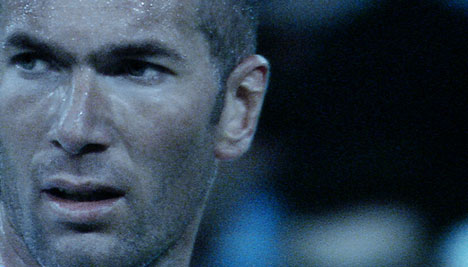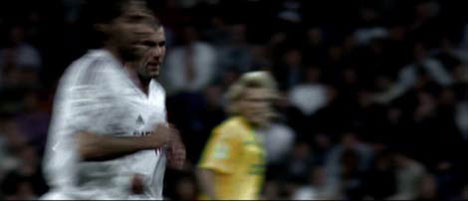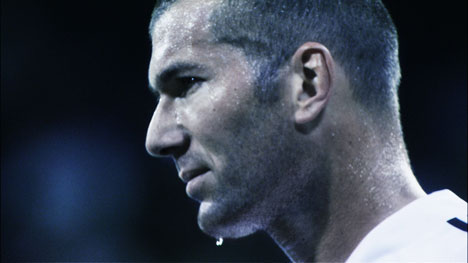
|
||
|
Portland art blog + news + exhibition reviews + galleries + contemporary northwest art
|
||
Zidane
I know this may sound a little strange but when you watch this film, you end up becoming a participant in the experience in a way that is unlike any film I had ever seen. The experience is structured around a soccer game but it goes much deeper than that. As I said before, the cameras are always focused on Zidane regardless of where the action is on the field. A first this is a little disconcerting but surprisingly it ends up allowing us to concentrate on the raw, visceral experience of playing soccer in front of 20,000 people in a packed stadium. By not following the ball, we get closer to the experience of the players. Second, the focus of our attention, Zidane, is never looking at us but always following the soccer game. The result is that we are like ghosts on the field, almost always on the periphery of the action of the soccer game. The game itself is nearly always outside our field of view. Players enter and exit the field of view of the camera based on a system that we are not able to perceive from our limited viewpoint. We have no sense of the flow or the overall structure of the game so we float but we are constantly immersed in the sensations and the experience of the moment.
The third perspective in the film would be Zidane's and even though we never experience the game through his eyes, we get a feeling of what is happening by watching his reactions. The filmmakers took a big jump when they decided to film soccer game not as it is but what it does. Of course, what it does is provoke reactions in both the players and the spectators. And then it hits you, how is the Zidane's reactions of the game, even though he is an occasional participant, any more privileged than the thousands of the fans in the stadium? This is where my perception of the film might differ from Zidane's fans, but I think that the answer is that his view is not privileged, it is not the "true" perspective of the game despite the fact that he is the focus of the film. His view, his reactions are just one of many. Everyone's experience of the game is equally real and authentic. The crowds become active participants in the experience of the game. The players respond to the crowd. The crowd responds to the players. There is a feedback loop. We are always aware of the crowds cheering when things are going well and yelling when they aren't. The experience of the players on the field, the crowds in the stands, the fans watching it on TV and the audience that are watching the film after the game has already been over for several years all feddback into one another. Everyone is responding to everyone else while the cause of the event, the soccer ball remains mostly invisible to us. Zidane is responding to the game the same as we are. He is responding aware of the cheering of the fans. We realize that we are all participants. We are all creating the reality of the game. The effect can only be described as the film makes us aware of the overlapping spheres of consciousness between the players, the spectators and ourselves. All of our experiences become interwoven and everything appears seamlessly interconnected. Our view of reality is limited only by our perspective.
The filmmakers reinforce this perception by introducing Zidane talking about his own experiences when the music is playing. It is in these moments that we become closest to feeling who Zidane is. In the film even though he is the focus of our attention, he is always following the game and never looking at us. With the music as a background and separated from the intensity of the game, we come closest to existing in his head. It is almost like we are hearing an internal monologue in our own heads in a soccer game in which we are playing. The different shifts in perception that we see in the different point of view of the cameras are reinforced in the way that the sounds of the film connects us to different aural aspects of the experience: the sounds of the game and the players, the sounds of the fans in the stands, the sound of Zidane's internal monologue and even the sounds of theater in which we are sitting. No part or perspective of the experience is privileged; we almost always exist on the periphery because there is no fixed center. The film opens with an extreme close up of a television or movie screen. I think that at one point in our lives it is an experience in which we have all participated. When we look at the screen up close, we do not see the image but we see very small colored dots that change according to their own logic. When we see the dots from a distance they merge to form an image that we can respond to but when we viewed up close, each dot seems to exist individually. Each dot contains a little bit of information that is necessary to be able to view the picture as a whole. It is almost as if the filmmakers are drawing a parallel between the relationship between the colored dots and the picture and the way our individual experience relates to our collective view of the reality of the game. As soccer players, fans in the stadium, filmmakers or even the audience of the film of the game, we all have a little bit to contribute. Each one of us provides a little bit of information. Each one of us supplies one more perspective the experience. It is only together that we create the whole image.
Posted by Arcy Douglass on September 13, 2008 at 9:20 | Comments (0) Comments Post a comment Thanks for signing in, . Now you can comment. (sign out)
(If you haven't left a comment here before, you may need to be approved by
the site owner before your comment will appear. Until then, it won't appear
on the entry. Thanks for waiting.)
|
| s p o n s o r s |
 |
 |
 |
 |
 |
 |
 |
 |
 |
 |
 |
 |
 |
 |
 |
 |

|
Site Design: Jennifer Armbrust | • | Site Development: Philippe Blanc & Katherine Bovee | |





